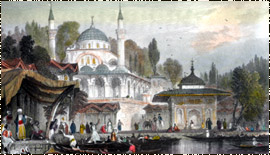 Ottoman rule extended over a period of about 700 years and, at its height, the Ottoman Empire covered a vast territory that included most of the regions adjoining the eastern and southern Mediterranean. Consequently, the character of Ottoman architecture underwent numerous changes over the course of this lengthy era. The architectural heritage of the Ottomans may be divided into three periods, beginning with the early formative phase, which extends until about the mid-9th / mid-15th century. This is followed by the classical period, which extends into the 11th / 17th century, and to which belongs most of the better-known monuments of Ottoman architecture, a number of which were designed by the great Ottoman architect Sinan. This is followed by the late period, which is characterised by more ornate decorative programs and increasing levels of Western influence. In terms of geography, the character of Ottoman architecture changes as the distance increases from the heartland of the Ottoman Empire in western Anatolia and Thrace, and concessions therefore are made to local architectural traditions for buildings constructed in the Ottoman provinces.
Ottoman rule extended over a period of about 700 years and, at its height, the Ottoman Empire covered a vast territory that included most of the regions adjoining the eastern and southern Mediterranean. Consequently, the character of Ottoman architecture underwent numerous changes over the course of this lengthy era. The architectural heritage of the Ottomans may be divided into three periods, beginning with the early formative phase, which extends until about the mid-9th / mid-15th century. This is followed by the classical period, which extends into the 11th / 17th century, and to which belongs most of the better-known monuments of Ottoman architecture, a number of which were designed by the great Ottoman architect Sinan. This is followed by the late period, which is characterised by more ornate decorative programs and increasing levels of Western influence. In terms of geography, the character of Ottoman architecture changes as the distance increases from the heartland of the Ottoman Empire in western Anatolia and Thrace, and concessions therefore are made to local architectural traditions for buildings constructed in the Ottoman provinces.
The architecture of the Ottomans, especially after the early formative period, is primarily built of stone. Ottoman architecture in fact is known for the very high quality of its masonry. Still, combinations of brick and stone are very common, and brick is used for arches, domes and vaults. Lead is used to cover domes and minaret caps, especially from the 10th / 16th century onwards. Polychrome glazed ceramic tiles, such as the renowned Iznik tiles in which white and blue dominate, are used extensively as wall coverings, and by the 10th / 16th century often replace marble as a sheathing material. Wood is used both as a structural and as a decorative material, and it is the predominant material for the houses of the Ottoman capital, Istanbul.

A major characteristic of Ottoman mosques from the early period is the dominance of a central dome that covers a significant part of the prayer hall. With the advent of the classical Ottoman phase, this central dome increases dramatically in size and is often combined with a series of half-domes and small domes that cascade from the central dome, with the overall arrangement fitting within a pyramidal outline. A number of mosques have one, two, or four half-domes supporting the central dome. The domes in Ottoman architecture have a semi-circular flat profile. An arcaded courtyard usually flanks the prayer hall along the façade located opposite the qibla wall.
Large imperial Ottoman religious complexes usually feature a significant number of facilities, which, in addition to a mosque, may include a mausoleum for the patron, a soup-kitchen, madrasa, public bath, hospital and shops.
The Ottoman mosque is well-known for its simple, elegant pencil-shaped minaret, which is often fluted and ends in a lead-covered, elongated conical cap. Such minarets are a clear indication of Ottoman-sponsored buildings throughout the Ottoman Empire. The minarets may have anything from one to three balconies, usually resting on corbelled muqarnas vaults. Mosques with royal patronage have more than a single minaret, ranging from two to six.
The Muqarnas is used selectively in certain areas, such as the underside of minaret balconies or above windows and portals. Calligraphy, usually featuring the naskhi and thuluth scripts, is an integral part of the decorative programme of many buildings. Applied surface decoration in Ottoman architecture of the classical phase is more restrained than it is in the earlier Anatolian Seljuq and early Ottoman periods, as well as in the later Ottoman period.
Ottoman architecture demonstrates the influences of numerous traditions including those of the Anatolian Seljuqs and Byzantium, both of which existed in Anatolia when the Ottomans rose to power. More specifically, the Imperial Ottoman mosques of the classical period show the clear influence of the mid-6th century AD Byzantine church of Hagia Sophia.
инфо: http://www.discoverislamicart.org/gai/ISL/page.php?theme=10

Няма коментари:
Публикуване на коментар